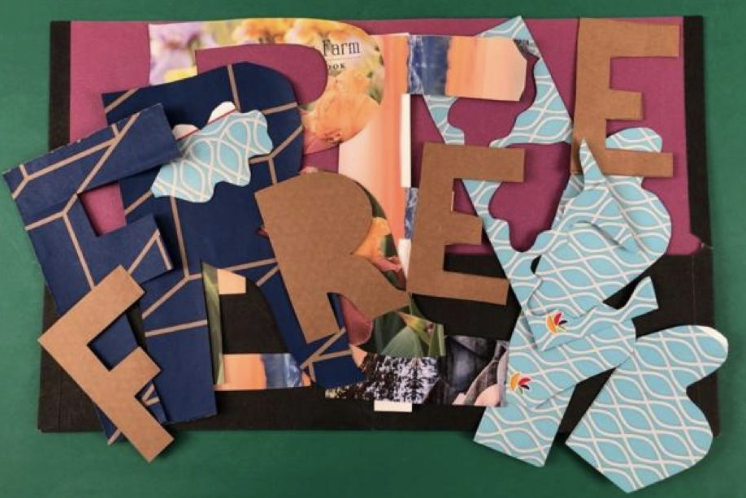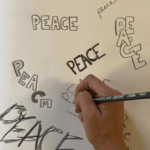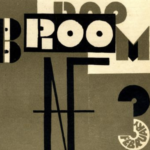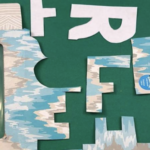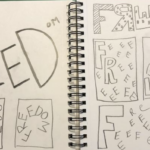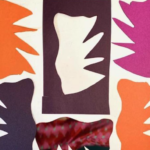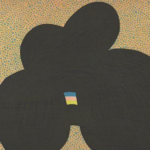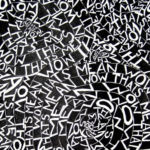Overview
In this unit, students will create a graphic collage self-portrait using letterforms, rubbings, and templates.
Lessons
Materials and Tools
- Paper (white and solid colors)
- Glue
- Scissors
- Graphite pencil
- Eraser
- Tape
- Colored pencils and crayons (optional)
Alternative Materials
- Heavy duty railroad board or tagboard can be used in the classroom if recycled cardboard is unavailable
- Corrugated cardboard that is single sided, such as Corrobuff or a wrap roll from Uline, is easier to cut and manipulate for students who have difficulty with scissors
- For classrooms with a printer, students can research and print images or text and include it in their sculpture as described in Lesson 9
Objectives
- Students will learn about and implement the elements of art and principles of design
- Students will build problem-solving skills through experimentation with composition
- Students will understand that they can express aspects of themselves through their artistic choices
Student Outcomes
Students will understand that:
- Visual elements of a work of art express ideas
- Color, shape, texture, and line are foundational to design
- An artist conveys personal meaning in a self-portrait
Students will be able to identify:
- How typography expresses different meanings and apply this knowledge to create their own letter design to express their feelings and ideas
- How the elements and principles of design create a visually dynamic and meaningful composition and create a composition demonstrating awareness of these concepts
Resources
The story of typeface designer Tré Seals, founder of Studio Seals and Vocal Type Co:
https://www.vocaltype.co/story-of
New Online Courses for Educators!
Fall Session Starts September 16!
Adaptations
For Students with Disabilities
- Students can build letter forms using pre-cut shapes or negative shape scraps if scissor cutting is too difficult
- Ask students to make choices and help by facilitating technical processes
- Students can use technology by manipulating text on an iPad or in Google Classroom
- Students can make a digital collage instead of a physical one
- Use audio with visuals in student-facing lesson guides
For Multilingual Learners
- Students can use this exercise to take a deep dive into the meaning of a chosen descriptive word in English
- Students can be given an edited list of personal descriptive words to use to reinforce vocabulary that is being taught
- Students can select a word from their language of origin to work with and share with the class as a language-learning tool for the whole class
- Use images of techniques paired with vocabulary words to help with meaning
- Chunk information and keep instructions concise
- Have multiple entry points: speaking, showing, and doing
- Use audio with visuals in student-facing lesson guides
Extensions
Scrap Material Letters
Students can create letters using scrap materials without cutting with scissors. When students can be in class together, finding letter forms can become an ice-breaker game.
Class Group Project
Choose a quote or affirmative aphorism to design. Individual students or small teams can construct their own words or letters and the project can be put together in the classroom or hallway. If students are at home, photos of their work can be collaged together on a single page or as an animated slideshow.
Create a slideshow of student’s self-portraits to share with the school community.
New York Teaching & Learning in Visual Arts Standards
Art Making: 12th Grade Learning Indicators for Drawing, Collage, and Graphic Design
Create a collection of drawings that demonstrates:
- A personal style
- The use of the figure or a non figurative subject to represent an idea, concept, or personal view
Create a mixed-media collage that demonstrates:
- Personal vision and/or reference to a social issue
- Mastery in cutting, tearing, and gluing techniques
- Inclusion of a variety of media and materials
- Ability to incorporate/synthesize printed images and text
- Mastery of principles of design to create a unified composition
Create a design that demonstrates:
- Selective use of the elements of art and principles of design
- A synthesis of shape, pattern, rhythm, and movement into a unified work
- Purposeful use of an image (e.g., a logo or a picture in a print ad) commenting on a social issue
- Text integrated with, and supporting, a graphic image
Literacy in the Arts
- Looking At and Discussing Art
- Developing Visual Arts Vocabulary
- Reading and Writing About Art
- Problem Solving: Interpreting and Analyzing Art
Making Connections
- Recognizing the Societal, Cultural, and Historical Significance of Art; Connecting Art to Other Disciplines
- Connecting Art to Other Disciplines
- Observing and Interpreting the World
Community and Cultural Resources
- Cultural Institutions
- Public Art and Design
- Online Resources and Libraries
Careers and Lifelong Learning
- Awareness of Careers in Visual Arts
- Art for Enjoyment and Lifelong Learning
NYS Learning Standards for the Arts
Artistic Process: Creating
Anchor Standards:
- Anchor Standard 1: Generate and conceptualize artistic ideas and work
- Anchor Standard 2: Organize and develop artistic ideas and work
- Anchor Standard 3: Refine and complete artistic work
Artistic Process: Presenting
Anchor Standards:
- Anchor Standard 4: Select, analyze, and interpret artistic work for presentation
- Anchor Standard 5: Develop and refine artistic techniques and work for presentation
- Anchor Standard 6: Convey meaning through the presentation of artistic work
Artistic Process: Responding
Anchor Standards:
- Anchor Standard 7: Perceive and analyze artistic work
- Anchor Standard 8: Interpret meaning in artistic work
- Anchor Standard 9: Apply criteria to evaluate artistic work
Artistic Process: Connecting
Anchor Standards:
- Anchor Standard 10: Relate and synthesize knowledge and personal experiences to inspire and inform artistic work
- Anchor Standard 11: Investigate ways that artistic work is influenced by societal, cultural, and historical context and, in turn, how artistic ideas shape cultures past, present, and future
Credits
Writing Team
Anne-Marie McIntyre, Josef Zutelgte, Jamie Powell
Project Team
Belinda Blum, Nicola Giardina, Paul Urevitch, Andrea Burgay
Studio in a School NYC Team
Julie Applebaum, Senior Director
Hasna Muhammad, Ed.D., Chair, Board of Directors, Studio in a School Association
Alison Scott-Williams, President, Studio in a School NYC
NYC Department of Education OASP Team
Karen Rosner, Director of Visual Arts
Amber Lodman, Arts Program Manager
Kaitlin Trammell, Remote Arts Learning Partnership Project Coordinator
NYC Department of Education Visual Arts Teacher Team
Maria Bonilla, Amie Robinson, Susan Bricker, Lara Tyson
These educational materials were created through a partnership with Studio in a School NYC and The New York City Department of Education Office of Arts and Special Projects (OASP) and made possible by the generosity of The New York Community Trust.
Copyright © 2023 Studio in a School NYC LLC

